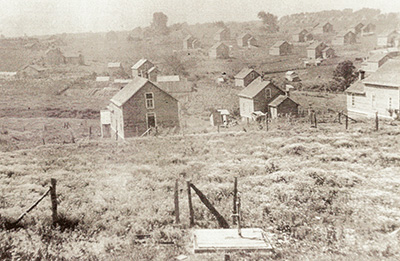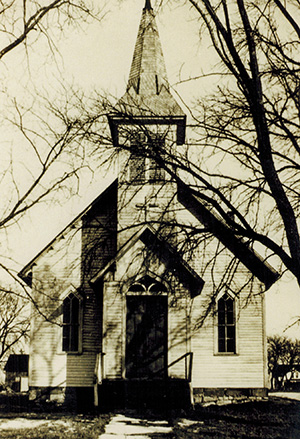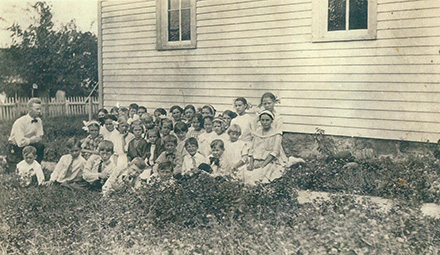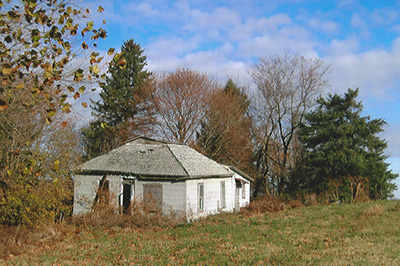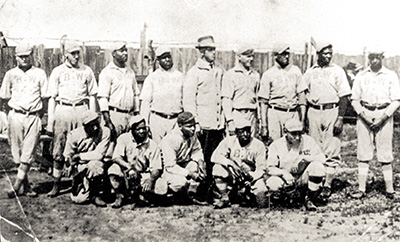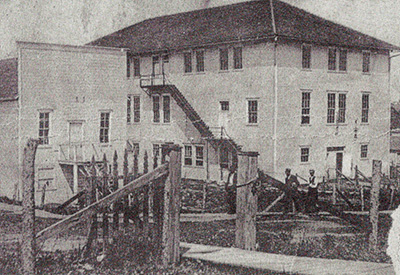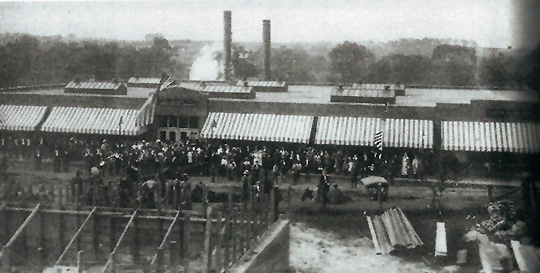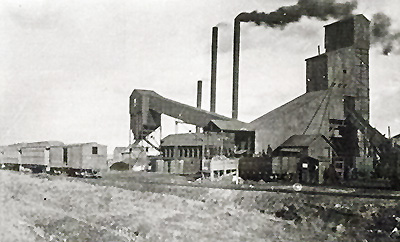Editors Note: Buxton was once a thriving community, located in the southwest corner of Mahaska County. Today, there is little to be seen by a visitor except a few foundations of buildings which once stood where now there are weeds.
Buxton, Iowa - The Coal Mining Town That Died
Published in the Oskaloosa Herold
August 3, 1970
Story
by Mrs. Hazel Nylander
Aunt Hazel Nylander was married to my grandma Emma's younger brother Hjalmer.
BUSSEY - Buxton, which has been described as “the toughest town east of Dodge City,” wasn’t really such a tough town. I lived there for a number of years. There was gambling, drinking, knife wielding and gun shooting, but most towns of the time had a certain degree of lawlessness. The social life of Buxton more than balanced the shady side.
The town was a mixture of whites and blacks, who had been brought in to work in the coal mines which were the town’s main support. It was predominantly black, but cooperation between the races was good.
I never heard of any cases of purse-snatching or house robbery although the Buxton streets were poorly lit and in winter, were quite dark. I was employed in the mercantile store and had to go home on the dark streets, and I can honestly say I was never accosted or treated disrespectfully.
Besides Buxton proper, there were other communities, such as East Swede Town, which consisted of about 35 buildings. The main feature of this small community was the Swedish Lutheran Church, which held its meeting in Swedish until World War I, when they changed to English.
People came from miles around to see the beautiful original painting of Jesus kneeling on the mountain, which was on the church’s east wall. It was done in colors, and when the candles in the brass candelabra were lit, the painting came to life. The church was destroyed by fire after Buxton was abandoned.
Church activities contributed much to the social life of the white youth of the community. Ice cream socials, coffee and cake socials, box suppers, mid-summer festivals and bazaars were held. If someone spent more than he had on hand at the time of the bazaar, he was given a full year to pay for it.
West Swede Town’s main feature was her two Methodist churches, one white and one colored. They were located near each other, but were completely separate organizations. We were invited once to hear a small boy minister speak in the colored church, and a number accepted the invitation. We were treated with respect and enjoyed the talk very much.
Hayestown was another adjoining community. It contained a number of homes owned by Mr. Hayes, a butcher shop and photographer’s studio. Many young people went to the studio to have pictures taken in glamorous poses. I still have some of mine taken over 60 years ago.
Coopertown had two livery stables, one owned by George Ross and one by Joe Harris. Ross would drive a hack twice a day to Hamilton, no matter what the weather, to meet the train there.
The young people of today can’t feature what it was like to take a buggy ride with your special gentleman friend. A few young men had their own horses and buggies, but most rented them from stables. What fun it was to spend a Sunday having a picnic near the Des Moines River at Tracy. Coopertown also had a colored hotel which was later destroyed by fire, a grocery store run by two white men, and a colored doctor.
Coopertown’s social life was sparked by the dances held in its large dance hall. It had been erroneously reported that whites and blacks held dances together. The dances were always racially segregated, and no one ever tried to crash them. Skating parties were also held in the building, but they, too, were always racially separate.
The Lodge held dances for the white young people, too. Dance programs were provided and refreshments of sandwiches, potato salad, and soft drinks, but no hard liquor was sold.
There were two tailor shops, one run by a colored tailor who made peg-topper trousers, which were a must for the well-dressed young gentleman. The other tailor specialized in men’s suits.
The only house left now in old Buxton was owned by Johnny Thomas, and is presently owned by the Carlsons, who live in it. The house was once part of the Thomas addition, a number of connected buildings owned by Johnny Thomas.
The coal mines were some distance from the town, so the miners had to be transported to them on trains. It cost ten cents a month to ride the train. It was quite a sight when the miners came into the depots at night with their miner’s lamps on their hats. There were no lights in the railroad coached, but there was heat.
Water and coal were delivered by the coal company to the houses in town. The company had built cisterns at most of the houses, and there were a few wells, but most of the water was hauled in. This was quite a project, when it was considered that Buxton had 9,000 inhabitants at one time.
The Buxton Wonders baseball team provided summer entertainment. The first team was made up of Negroes. They played many professional teams and won their fair share of the games. The second team was racially integrated. They also played some professional teams, were in great demand to play at places for miles around, and drew large crowds.
Another place of amusement was the park, which boasted a year-round merry-go-round. Carnivals, though not as elaborate as today’s, were held in the park, and were enjoyed by all. If town young couples happened to be together at the carnival, one would promise to have their fortunes told by the gypsy fortune teller if the others would promise also. The first couple would then proceed to tell the gypsy all about the other couple, who would be amazed at the gypsy’s knowledge.
There were two colored bands, which were directed by brothers. They played for dances and skating parties. Their concerts were well-attended, since there was no television or radio then. A colored quartet was often hear, too, and it was very much in demand at fairs and other gatherings.
The first time I ever heard a radio was in a room at the mercantile store where I worked. Between the squawks and squeaks we managed to hear a little music, but it was nothing like the wonderful music we hear today on radio and television. You had to try hard to hear anything above the moaning and groaning.
Ice skating was a popular winter sport. There was a certain reservoir that was always used for skating. After the ice got to a certain thickness, it was cut into blocks and stored in ice houses to be used the next summer. We also had bobsled races. Hayrides were popular in the summer.
The YMCA was a three-story building with heat and electricity. It was Buxton’s pride and joy. The first floor was a gymnasium with pool tables, a boxing ring, and other equipment. The second floor was a theater, and since the YMCA wad on the theater circuit, minstrel shows, like the Maharas and McCabe Minstrels, girlie shows, dramas, tear jerkers and professional boxing matches were held there.
When silent movies began, they were shown in the YMCA theater. Two French women, the Langlois sisters, ran the movies. One would run the projector, and the other would provide the background music and sounds. Of course, one had to be an accomplished musician to give the sound of horses galloping one minutes, and hearts and flowers music the next.
We attended the movies as often as possible, and, though the reel would always break part way through the film, we thoroughly enjoyed it. The top floor of the YMCA was given over to Lodges. A number of groups met there. An annex to the building was used for dances and skating parties.
The company mercantile store was truly remarkable for its time. It was built after the first store was destroyed by a fire. I lived at a camp called Eveland, which was three miles from the store, and I saw the flames of the fire in the first store from my home.
The new store had a complete basement and a row of windows stretched across the front. A window decorator was employed to do nothing by decorate windows and set up floor displays throughout the store.
There were ladies wear, dry goods, drugs, grocery, shoe and hardware departments, not to mention a complete line for miner’s tools, china, and cooking utensils.
The grocery department was quite different from modern grocery stores. The sugar and flour came in large sacks and butter, lard, vinegar, kraut and peanut butter came in large containers. All were measure out to the exact amount the customer required.
I’ll never forget the first olives we tasted at the store. They came in a large container, as most of the products did, and after tasting them, we predicted they would never be a success.
A floor walker and a boy to open the front door were employed by the store. Most of the goods were sold on charge accounts, and all the business had to go through the main credit office, which was presided over by Mrs. Christie.
I worked in the store for three years, and it was a marvelous experience. Both whites and blacks were employed and there was no friction, but there was no mingling activities outside the store and its business, either.
Buxton had its own electricity supply which provided power for the store, YMCA, and some of the houses. It all so had its own telephone exchange.
Buxton is gone now, just as if a bomb had destroyed her and after those who lived there are gone, it will not be remembered, but if it is at all, I sincerely hope it will be remembered for all the good people who lived there, and not as “the toughest town east of Dodge City.”

